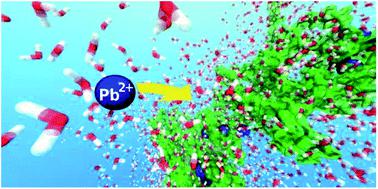当前位置:
X-MOL 学术
›
Chem. Sci.
›
论文详情
Our official English website, www.x-mol.net, welcomes your
feedback! (Note: you will need to create a separate account there.)
How natural materials remove heavy metals from water: mechanistic insights from molecular dynamics simulations
Chemical Science ( IF 7.6 ) Pub Date : 2021-1-11 , DOI: 10.1039/d0sc06204a Fabio Pietrucci 1 , Mauro Boero 2 , Wanda Andreoni 3, 4
Chemical Science ( IF 7.6 ) Pub Date : 2021-1-11 , DOI: 10.1039/d0sc06204a Fabio Pietrucci 1 , Mauro Boero 2 , Wanda Andreoni 3, 4
Affiliation

|
Water pollution by heavy metals is of increasing concern due to its devastating effects on the environment and on human health. For the removal of heavy metals from water sources, natural materials, such as spent-coffee-grains or orange/banana/chestnut peels, appear to offer a potential cheap alternative to more sophisticated and costly technologies currently in use. However, in order to employ them effectively, it is necessary to gain a deeper understanding – at the molecular level – of the heavy metals-bioorganic-water system and exploit the power of computer simulations. As a step in this direction, we investigate via atomistic simulations the capture of lead ions from water by hemicellulose – the latter being representative of the polysaccharides that are common components of vegetables and fruit peels − as well as the reverse process. A series of independent molecular dynamics simulations, both classical and ab initio, reveals a coherent scenario which is consistent with what one would expect of an efficient capture, i.e. that it be fast and irreversible: (i) binding of the metal ions via adsorption is found to happen spontaneously on both carboxylate and hydroxide functional groups; (ii) in contrast, metal ion desorption, leading to solvation in water, involves sizable free-energy barriers.
中文翻译:

天然材料如何从水中去除重金属:分子动力学模拟的机械原理
由于重金属对环境和人类健康造成毁灭性影响,人们日益关注重金属对水的污染。为了从水源中去除重金属,天然材料,例如废咖啡粒或橙子/香蕉/栗子皮,似乎是当前使用的更复杂,更昂贵的技术的潜在廉价替代品。但是,为了有效地使用它们,有必要在分子水平上对重金属-生物有机-水系统有更深入的了解,并利用计算机模拟的力量。作为朝这个方向迈出的一步,我们通过原子模拟通过半纤维素从水中捕获铅离子(半纤维素代表了蔬菜和果皮的常见成分)以及反向过程。一系列独立的分子动力学模拟,包括经典和从头算,揭示了一个连贯的场景,与人们期望的高效捕获相一致,即它是快速且不可逆的:(i)通过吸附结合金属离子是发现在羧酸盐和氢氧化物官能团上均自发发生;(ii)相反,导致水中溶解的金属离子解吸涉及相当大的自由能壁垒。
更新日期:2021-01-15
中文翻译:

天然材料如何从水中去除重金属:分子动力学模拟的机械原理
由于重金属对环境和人类健康造成毁灭性影响,人们日益关注重金属对水的污染。为了从水源中去除重金属,天然材料,例如废咖啡粒或橙子/香蕉/栗子皮,似乎是当前使用的更复杂,更昂贵的技术的潜在廉价替代品。但是,为了有效地使用它们,有必要在分子水平上对重金属-生物有机-水系统有更深入的了解,并利用计算机模拟的力量。作为朝这个方向迈出的一步,我们通过原子模拟通过半纤维素从水中捕获铅离子(半纤维素代表了蔬菜和果皮的常见成分)以及反向过程。一系列独立的分子动力学模拟,包括经典和从头算,揭示了一个连贯的场景,与人们期望的高效捕获相一致,即它是快速且不可逆的:(i)通过吸附结合金属离子是发现在羧酸盐和氢氧化物官能团上均自发发生;(ii)相反,导致水中溶解的金属离子解吸涉及相当大的自由能壁垒。











































 京公网安备 11010802027423号
京公网安备 11010802027423号